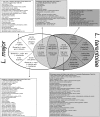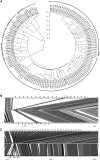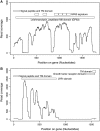Genome sequencing of the lizard parasite Leishmania tarentolae reveals loss of genes associated to the intracellular stage of human pathogenic species
- PMID: 21998295
- PMCID: PMC3273817
- DOI: 10.1093/nar/gkr834
Genome sequencing of the lizard parasite Leishmania tarentolae reveals loss of genes associated to the intracellular stage of human pathogenic species
Abstract
The Leishmania tarentolae Parrot-TarII strain genome sequence was resolved to an average 16-fold mean coverage by next-generation DNA sequencing technologies. This is the first non-pathogenic to humans kinetoplastid protozoan genome to be described thus providing an opportunity for comparison with the completed genomes of pathogenic Leishmania species. A high synteny was observed between all sequenced Leishmania species. A limited number of chromosomal regions diverged between L. tarentolae and L. infantum, while remaining syntenic to L. major. Globally, >90% of the L. tarentolae gene content was shared with the other Leishmania species. We identified 95 predicted coding sequences unique to L. tarentolae and 250 genes that were absent from L. tarentolae. Interestingly, many of the latter genes were expressed in the intracellular amastigote stage of pathogenic species. In addition, genes coding for products involved in antioxidant defence or participating in vesicular-mediated protein transport were underrepresented in L. tarentolae. In contrast to other Leishmania genomes, two gene families were expanded in L. tarentolae, namely the zinc metallo-peptidase surface glycoprotein GP63 and the promastigote surface antigen PSA31C. Overall, L. tarentolae's gene content appears better adapted to the promastigote insect stage rather than the amastigote mammalian stage.
Figures







Similar articles
-
Searching for virulence factors in the non-pathogenic parasite to humans Leishmania tarentolae.Parasitology. 2009 Jun;136(7):723-35. doi: 10.1017/S0031182009005873. Epub 2009 May 6. Parasitology. 2009. PMID: 19416551
-
Identification of a gp63 surface glycoprotein in Leishmania tarentolae.FEMS Microbiol Lett. 1992 Sep 1;75(1):89-92. doi: 10.1016/0378-1097(92)90461-v. FEMS Microbiol Lett. 1992. PMID: 1526469
-
Maxicircle (mitochondrial) genome sequence (partial) of Leishmania major: gene content, arrangement and composition compared with Leishmania tarentolae.Gene. 2008 Nov 15;424(1-2):80-6. doi: 10.1016/j.gene.2008.07.026. Epub 2008 Jul 30. Gene. 2008. PMID: 18718512
-
Evolution and expression of the Leishmania surface proteinase (gp63) gene locus.Infect Agents Dis. 1993 Feb;2(1):25-34. Infect Agents Dis. 1993. PMID: 8162351 Review.
-
Leishmania tarentolae: Taxonomic classification and its application as a promising biotechnological expression host.PLoS Negl Trop Dis. 2019 Jul 25;13(7):e0007424. doi: 10.1371/journal.pntd.0007424. eCollection 2019 Jul. PLoS Negl Trop Dis. 2019. PMID: 31344033 Free PMC article. Review.
Cited by
-
Genome Sequencing of Leishmania infantum Causing Cutaneous Leishmaniosis from a Turkish Isolate with Next-Generation Sequencing Technology.Acta Parasitol. 2021 Mar;66(1):75-80. doi: 10.1007/s11686-020-00252-9. Epub 2020 Jul 20. Acta Parasitol. 2021. PMID: 32691361 Review.
-
Studies of the Effectiveness of Bisphosphonate and Vanadium-Bisphosphonate Compounds In Vitro against Axenic Leishmania tarentolae.Oxid Med Cell Longev. 2016;2016:9025627. doi: 10.1155/2016/9025627. Epub 2016 Feb 29. Oxid Med Cell Longev. 2016. PMID: 27034744 Free PMC article.
-
The selenocysteine tRNA gene in leishmania major is transcribed by both RNA polymerase II and RNA polymerase III.Eukaryot Cell. 2015 Mar;14(3):216-27. doi: 10.1128/EC.00239-14. Epub 2014 Dec 29. Eukaryot Cell. 2015. PMID: 25548151 Free PMC article.
-
Saurian-associated Leishmania tarentolae in dogs: Infectivity and immunogenicity evaluation in the canine model.PLoS Pathog. 2024 Oct 9;20(10):e1012598. doi: 10.1371/journal.ppat.1012598. eCollection 2024 Oct. PLoS Pathog. 2024. PMID: 39383180 Free PMC article.
-
Plasticity of the Leishmania genome leading to gene copy number variations and drug resistance.F1000Res. 2016 Sep 20;5:2350. doi: 10.12688/f1000research.9218.1. eCollection 2016. F1000Res. 2016. PMID: 27703673 Free PMC article. Review.
References
-
- Murray HW, Berman JD, Davies CR, Saravia NG. Advances in leishmaniasis. Lancet. 2005;366:1561–1577. - PubMed
-
- Noyes HA, Chance ML, Croan DG, Ellis JT. Leishmania (sauroleishmania): A comment on classification. Parasitol. Today. 1998;14:167. - PubMed
-
- Simpson L, Holz G. The status of Leishmania tarentolae/Trypanosoma platydactyli. Parasitol. Today. 1988;4:115–118. - PubMed
-
- Elwasila M. Leishmania tarentolae Wenyon, 1921 from the gecko Tarentola annularis in the Sudan. Parasitol. Res. 1988;74:591–592. - PubMed
Publication types
MeSH terms
Grants and funding
LinkOut - more resources
Full Text Sources
Other Literature Sources
Molecular Biology Databases

